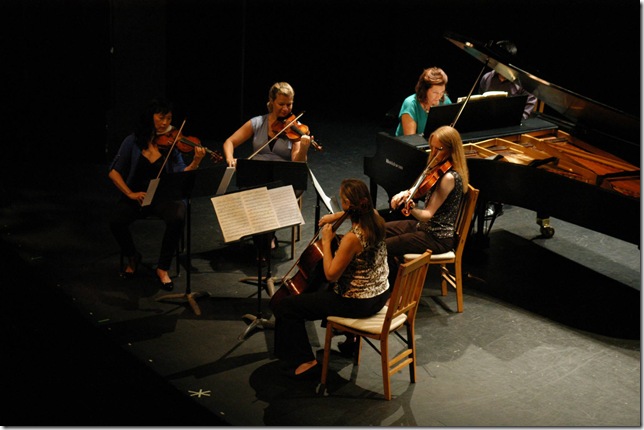A work of teenage exuberance was served up with high spirits and full-on late Romanticism on Sunday as the 22nd season of the Palm Beach Chamber Music Festival’s summer season came to a close at Delray Beach’s Crest Theatre.
The very first published opus of Ernst von Dohnányi (or Ernö Dohnányi, to give him his Hungarian name), a powerful Brahmsian piano quintet, occupied the second half of Sunday afternoon’s concert, and it came off surpassingly well. The chief reason was that the five musicians — violinists Mei Mei Luo and Dina Kostic, violist Rene Reder, cellist Susan Moyer Bergeron and pianist Lisa Leonard — identified completely with Dohnányi’s expansive idiom and played it to the hilt.
The Dohnányi quintet was written by a 17-year-old composer who already was a splendid pianist, and ready to show that off. And so the piano part of this quintet is a bravura affair, which Leonard pulled off admirably. The four string players performed this music with a sense of emotional directness and warmth that beautifully communicated its potency.
That could be heard clearly in the first movement, with the sweep the musicians gave to the main march-like theme, and to the tasteful approach they gave to the contrasting theme, which could easily have been mawkish especially given its now-hackneyed harmonic layout. The second movement, an almost-Mendelssohnian scherzo, is built on a nagging five-note motif and a repeating cadence formula. The interplay between piano and strings was exemplary, and the strings gave the sighing Trio theme a melting kind of warmth.
Violist Reder led off the slow movement with a nicely shaped solo statement of the primary theme, which grows, like three of this quintet’s movements, into a huge statement at a peak emotional climax; it was fascinating to hear the enormous sound the five players were able to produce here, and which was entirely appropriate for the all-out nature of the writing.
The finale, a catchy little tune in 5/4 time, comes back frequently, and the musicians were wise not to overdo it in the early going. The minor-key fugue in the middle was clear and precise, and the epic ending drew extensive applause from the Crest house.
The first half of the concert opened with Kostic and Reder performing the first of Mozart’s two duos for violin and viola (No. 1 in G, K. 423), written in 1783 as a goodwill gesture for Michael Haydn. Both duos are marvelous works, and the first one is richly contrapuntal.
Kostic and Reder performed the piece with impressive technical polish and full Mozartean spirit. The first movement had a wide-open sound and a just-right tempo that let the music sparkle. The slow movement, on the other hand, was played with a dreamy, cozy sound.
In the Rondo finale, one passage of busy figurations for the two instruments sounded like nothing so much as a fiddling contest, which added to the fun and wrapped a very fine reading of this delightful music. Perhaps in future festivals there could be more of a thematic approach to some aspects of the programming, so that, for example, we could hear both duos on subsequent concerts, or something like a summer featuring American wind quintets. In any case, this performance whetted the appetite for the B-flat major Duo, K. 424.
But what followed was something very different, the Pastorale of Stravinsky, a drawn from a song he wrote as a Rimsky-Korsakov student and subsequently rearranged for a wide variety of different instrumental and vocal combinations. This version, for violin, oboe, English horn, clarinet and bassoon, has a darkly rustic flavor, and the combination of light-toned violin with the bronze of the winds was very appealing. It was well-played, but while it began with a calm, placid feeling, it soon became forceful and stayed that way, so that the effect was one of tension rather than relaxation.
The final work on the first half was the Quintet in the Form of a Chôros, composed in 1928 by the prolific Brazilian composer Heitor Villa-Lobos. Written for flute, oboe, English horn, clarinet and bassoon, the piece is very much in the experimental mode of its time and contains many moments in which Villa-Lobos is aiming for color and musical onomatopoeia rather than anything like traditional sonata form.
Each of the five players — flutist Karen Dixon, oboist Erika Yamada, English hornist Dione Chandler, clarinetist Michael Forte and bassoonist Michael Ellert — had elaborate, florid passages to play amid a sonic landscape littered with fragments of birdsong and hints of big-city dance music. This is difficult, recondite music despite its debt to popular Brazilian styles, and the five musicians had clearly worked hard at making it come off.
The Villa-Lobos is not a particularly good piece, but it’s an interesting one, and it was played about as well as it could be played by the five musicians. Programming eclectic repertoire is one of the hallmarks of this festival, and it remains one of the few local classical music events that can be approached with anything like a sense of discovery.
The Palm Beach Chamber Music organization is holding its first-ever fall season this year with six performances in Lake Worth and Boca Raton. The three programs, performed twice, are set for Sept. 19-20, Oct. 10-11, and Nov. 14-15. Repertoire has not been set, but tickets are available for the Thursday concerts at Boca Raton’s Lynn University (237-9000 or lynn.edu/tickets) and the Friday concerts at St. Andrew’s Episcopal Church in Lake Worth (call 800-330-6874 or visit www.pbcmf.org.)
